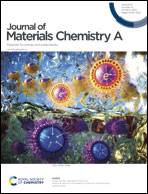Bimetallic MoNi/WNi nanoalloys for ultra-sensitive wearable temperature sensors†
Abstract
Continuous real-time monitoring of temperature has played an essential role in human health. Herein, we fabricated an all textile-based temperature sensor using nickel-molybdenum (MoNi) and tungsten-molybdenum (WNi) bimetallic nanoalloys, which exhibits high sensitivity and flexibility with a negative temperature coefficient (NTC). This is the first report of tetragonal phase MoNi4 and WNi4 nanoalloys in temperature sensing. The nanoalloys possess exceptional sensing performance, with nearly four orders of resistance variation from 25 to 330 °C, constant of thermistor B = 10 890 K (25–40 °C), and rapid response, endowing temperature sensors with promising application respiratory monitoring. Flexible respiratory sensors can still work under high humidity conditions (>95 RH%) without sacrificing accuracy and sensitivity. Besides the superior performance, the sensor possesses great practical potential with simple preparation, low cost and high stability. A potential application has been demonstrated in transmitting information by blowing the sensor according to Morse code, which can help people in a special environment to send information. It is believed that the bimetallic nanoalloy-based temperature sensors will hold great applications in flexible wearable devices.



 Please wait while we load your content...
Please wait while we load your content...